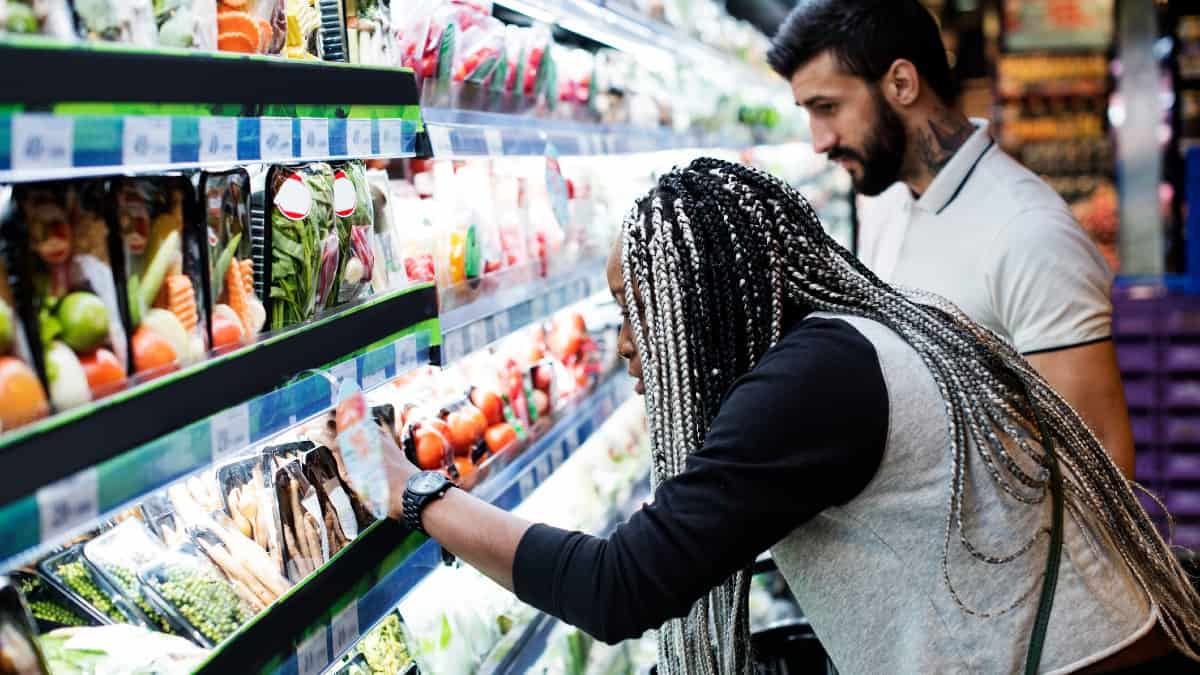Sixty years ago, when Giuseppe Divita’s grandparents opened their olive mill in Chiaramonte Gulfi, Sicily, the Italian island’s climate was ideal for producing the fruit.
This is no longer the case, says Divita, who, alongside his brother, runs Oleificio Guccione, which today has its own groves as well as the mill. With average annual temperatures climbing and rainfall dwindling, growing olives and turning them into oil is becoming increasingly difficult.
Throughout the Mediterranean, reduced yields and higher input costs for olive producers have pushed up prices to 20-year highs this year. The production problems are only going to get worse as the effects of climate become more acute, predicts Divita.
For millennia, food production and pricing have been disrupted by the weather, with one-off events such as heatwaves, droughts, flooding or frosts cutting harvests and raising prices. War and disease are also factors, as the world saw recently after Russia’s invasion of Ukraine, and the swine fever that swept through China’s pig population.
But another, more sustained thread has run through many sharp increases in food prices. From oranges in Brazil to cocoa in west Africa; olives in southern Europe to coffee in Vietnam, permanently shifting weather patterns as a result of climate change are reducing crop yields, squeezing supplies and driving up prices.
Adam Davis, co-founder of global agricultural hedge fund Farrer Capital, says climate change has helped drive up prices for a long list of food commodities trading at higher levels this year. “Wheat is up 17 per cent, palm oil 23 per cent . . . sugar 9 per cent and pork 21 per cent,” he says. For the consumer, the “lag effect of those high commodity prices is not going away”.
A third of the food price increases in the UK in 2023 was down to climate change, according to the Energy and Climate Intelligence Unit think-tank.
“There’s a material impact from climate change on global food prices,” says Frederic Neumann, chief Asia economist at HSBC. “It’s easy to shrug off individual events as being isolated, but we’ve just seen such a sequence of abnormal events and disruptions that, of course, add up to climate change impact.”
Such repeated events result in “a permanent impact on the ability to supply food,” argues Neumann. Food price rises once considered temporary are becoming a source of persistent inflationary pressure.
Globally, annual food inflation rates could rise by up to 3.2 percentage points per year within the next decade or so as a result of higher temperatures, according to a recent study by the European Central Bank and the Potsdam Institute for Climate Impact Research.

This will mean an increase in annual overall inflation of up to 1.18 percentage points by 2035, found the study, which used historic data from 121 countries from 1996 to 2021 to model future inflation scenarios. The global south stands to be the worst affected.
The question is how monetary policy should reflect this. Many central banks exclude food and energy prices from so-called core inflation, the measure they watch most closely, owing to their volatility.
But now that climate change is starting to cause sustained inflationary pressure, debate is growing over whether rate-setters should pay more heed — not least because the impact of rising food prices is felt keenly by ordinary citizens.
David Barmes, policy fellow at the London School of Economics’ Grantham Research Institute on Climate Change and the Environment, says regarding spikes in food inflation as temporary “is not really going to be a useful approach any more, if the price shocks are repeated and frequent and will affect headline inflation in a more persistent way”.
Neumann predicts that more frequent interruptions to food supply “will force central banks to respond, leading to more volatile interest rates, and possibly higher interest rates over time”.
The world is on track for a temperature rise of up to 2.9C above pre-industrial levels — almost double a target agreed at the 2015 Paris climate talks, according to a recent report published by the UN environment programme.
The pace of this warming is also increasing, defying even climate scientists’ expectations. Last year was the hottest year on record, but may be eclipsed by the current one as temperatures soar to nearly 50C in India and Europe braces itself for another scorching summer.
Agriculture is one of the sectors most directly affected. Over the next decade, some of the world’s most globally important crops may be in short supply as rising temperatures and more frequent extreme weather events hamper harvests.
Wheat yields, for example, are drastically reduced once spring temperatures exceed 27.8C, yet a recent study found that the major wheat-growing regions of China and the US were experiencing temperatures well in excess of this increasingly frequently.
Heatwaves that were expected to occur once every hundred years in 1981 are now expected every six years in the Midwestern US and every 16 years in northeastern China, according to the research by the Friedman School of Nutrition Science and Policy at Tufts University.
Rice, soyabeans, corn and potatoes are among other staples that could see yields plummet. For many crops, higher temperatures mean lower yields. “They have pretty stable productivity up to temperatures between 20C and 30C, depending on the crop,” says Friderike Kuik, an economist, who led the ECB study. “Beyond that, we see quite sharp declines.”
This fall in productivity leads to high food prices, she adds. “It’s just simple supply and demand.”
Extreme weather events, including droughts, floods and storms, that are becoming increasingly frequent also have knock-on effects.
Flooding in Pakistan in 2022 decimated the country’s rice fields, while climate change has compounded the effects of the El Niño sea temperature phenomenon, which returned last year, resulting in low yields of sugar, coffee and cocoa.
The changes in climate and weather patterns are also altering growing seasons and creating new pressures from pests and diseases. In Ghana and Ivory Coast, which produce two-thirds of the world’s cocoa beans, heavy rainfall last summer created the humid conditions perfect for black pod disease — a fungal infection which rots cocoa pods — to thrive.
This, coupled with other diseases and poor weather, knocked yields and led to a global crop more than 10 per cent smaller than the year before.
For farmers, the challenges posed by climate change mean higher input costs. Land that once produced ample crops from rainwater now needs to be irrigated and more pesticides are needed to keep diseases and bugs at bay.

In Sicily, with temperatures reaching 40C during harvest, the Divita brothers have had to introduce special chilling machinery. Hotter weather also affects labour productivity, increasing production costs that are passed on to consumers as higher prices.
Estimating the extent of this impact is challenging, says William Hynes, senior climate change economist at the World Bank. As in the case of the ECB study, most empirical literature looks at temperature increases because the data is readily available. But Hynes says there are numerous other ways in which climate change affects crop yields and food prices. “The whole system is changing.”
Crop yields will not suffer in every region. Some regions or countries may be able to grow more of certain crops as a result of changes in the climate, says Hynes, citing winemaking in England among other examples. Other parts of the world may be able to adapt by switching to hardier crops or more newly developed drought-resistant varieties.
Notwithstanding such adaptations, climate change is set to hinder not help the world’s food supplies, according to Paul Ekins, professor of resources and environment policy at University College London.
This leads to greater overall inflationary pressure as higher food prices feed through into higher costs of living. But the extent of this pressure varies.
The ECB researchers, for example, found that temperature increases prompted a sharp decline in productivity and rise in inflation once they exceeded a certain threshold. Depending on the crop, a temperature increase of 5C, from 20C to 25C, might have less impact on yields and inflation than one of 2C, from 34C to 36C, for example.

Regions such as South America and Africa already routinely experience temperatures close to the thresholds at which they become damaging to crops, says Kuik, “so it’s in those regions that further increases in temperature have a more significant impact on food prices”.
By contrast, more temperate Europe tends to endure the worst effects of climate change — and the accompanying inflation impact — during the summer months. In 2022, food inflation in Europe rose by around 0.6 percentage points as a result of the continent’s hot summer, the ECB’s researchers found.
Food also constitutes a larger share of household expenditures in developing economies — sometimes up to 50 per cent of the consumer price index — meaning any increase in prices has a magnified effect on overall inflation, according to HSBC’s Neumann. Higher food prices also reduce the money available for other items, stifling broader consumer spending.
“The food CPI itself is also much more sensitive to disruptions and swings in input prices,” says Neumann. Wheat might make up 70 per cent of the cost of bread in a low or middle-income country but as little as 10 per cent in a richer one, where labour, energy and transport costs are more significant.
Similarly, wealthy countries that are well-integrated into global markets are better able to deal with a failed harvest. “If a German wheat harvest goes wrong, they can buy their wheat on global markets,” Neumann adds. But a poorer country may neither be able to afford to go elsewhere, nor have the infrastructure to import large quantities of the food, he adds. “The [global] south is left holding the bag.”
Advanced economies are not off the hook, however, according to Gert Peersman, professor of economics at Ghent University, Belgium. His research suggests that in the medium term up to 30 per cent of the volatility in Eurozone inflation is caused by changes in international food prices, determined by unexpected global harvest shocks.
Even though food makes up a much smaller portion of household expenditure in rich countries, most people “look at food to form their [inflation] expectations”, says Peersman. This drives actual inflation, he and many other economists argue, as it pushes people to ask for higher wages.
Barmes agrees, saying that consumers “are very sensitive to food prices . . . so if climate change means that food prices are persistently going up, that does have a disproportionate effect on their inflation expectations.”
Some economists say that in advanced economies, companies with big market power can amplify inflation in times of supply disruptions. Isabella Weber, assistant professor of economics at the University of Massachusetts Amherst, says the inflation of the past few years “was triggered by shocks to essential sectors [such as food and energy] and then propagated by firms’ pricing decisions”.
The growing impact of climate change on agriculture is reigniting a debate over whether central banks should respond to food price shocks as they do generalised price increases — by raising interest rates.
For a long time, consensus held among economists was that they should not, says Marc Pourroy, associate professor of economics at the University of Poitiers in France. This was because food inflation was seen as temporary, mean-reverting and volatile. “You don’t want your interest rates to be volatile,” he adds.
Food price inflation has also tended to be driven by external global factors, which small economies in particular have no impact over. “Interest rate hikes don’t address negative supply side shocks,” says Barmes, adding that they can actually be counterproductive because they can further cut output.
Nor do they increase food supply, economists and other market analysts contended when monetary policy orthodoxy was challenged in response to the food price shocks of 2008 and 2011.
This time around, though, the parameters of the debate have shifted because of climate change, economists note.
Central banks in developing economies have always had to be more responsive to food prices, says Raghuram Rajan, who was governor of the Reserve Bank of India from 2013 to 2016.
“It may well be that developing countries have to take it more into account because it’s not only a big part of the budget, it’s also a secular trend and it’s become more volatile,” he adds.
As climate change takes hold and impairs crop yields, governments are also more and more likely to turn to protectionist policies which can exacerbate the inflationary impact. Last year, for example, Indian Prime Minister Narendra Modi imposed export restrictions on broken and non-basmati white rice varieties, sending commodity prices surging.
How to respond to this is more contentious. Barmes argues there is a need for alternative inflation control tools to deal with the pressures coming from climate change.
Implemented by fiscal and industrial authorities, rather than central banks, these might include price controls and targeted subsidies. Tighter competition policy and antitrust measures are also needed to prevent corporations with large market share from profiteering during inflationary periods and thereby exacerbating the problem, he adds.

Weber, the Amherst professor, argued in a recent paper that countries should build buffer stocks of food commodities to cushion against price fluctuations and levy windfall profit taxes against companies in essential sectors, such as food, to deter price gouging.
Neumann acknowledges that raising rates at a time when food prices are also rising comes with risks and is not always effective. But he adds that in most contexts “you cannot ignore food price shocks entirely, you should be raising interest rates”.
Rajan, the former RBI governor, agrees that “you have to be a little careful responding to things like the temporary shoot up in price of onions”, a short-term shock that is quickly fixed when more supply arrives.
But “you can’t just ignore [food prices]”, he adds, especially not when they are high for some time. Central banks must increase interest rates “not so much to kill this price increase, but to avoid everything else picking up with it”.
For smaller economies at least this appreciates the currency, says Pourroy, helping reduce the price of imports.
“Central banks should not overreact,” he says, but as the effects of climate change take hold, food inflation will be “too important for the economy, for the people, for them to do nothing”.
Climate Capital

Where climate change meets business, markets and politics. Explore the FT’s coverage here.
Are you curious about the FT’s environmental sustainability commitments? Find out more about our science-based targets here
Credit: Source link
















